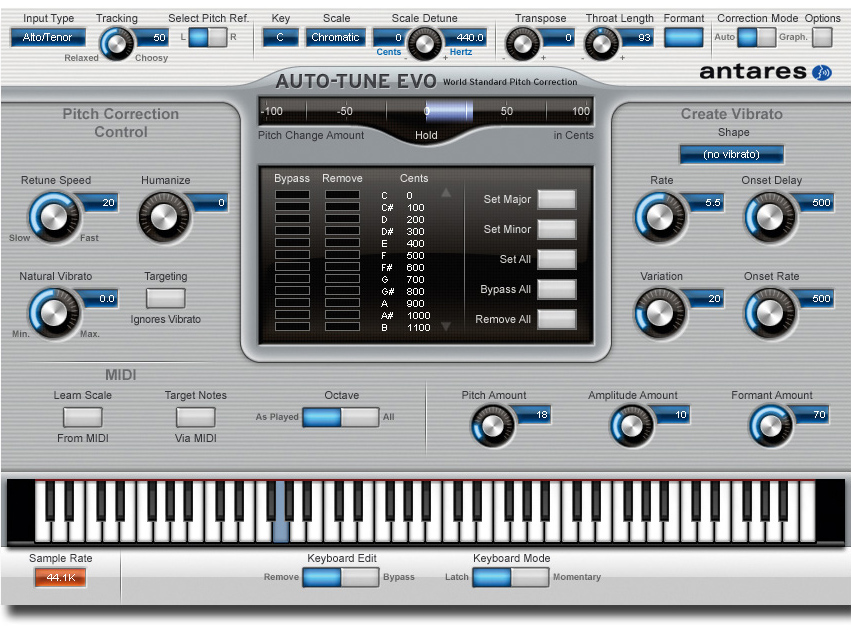MusicRadar Verdict
The best iteration of Auto-Tune yet offers great new features, easier editing and improved sound quality. Viva Evo!
Pros
- +
Easier to use than ever. More control over fine details. Note Objects system is great. Sounds impossibly good. More creative applications. Two MIDI input modes.
Cons
- -
No formant mode included in TDM version.
MusicRadar's got your back

Antares Auto-Tune Evo

Antares Auto-Tune Evo
Auto-Tune's capabilities range from gentle tuning improvements to hard, robotic tuning that's anything but subtle.
Over the years, other companies have taken shots at creating alternative tuning products, with varying degrees of success. Antares, meanwhile, has continued to develop a variety of (mostly vocal-orientated) effect plug-ins, including new versions of Auto-Tune, raising the bar a little each time.
In recent months, Auto-Tune has enjoyed a surge in popularity, with artists such as T-Pain relying on it for their signature sounds.
Improvements
Auto-Tune Evo represents a jump forward in functionality. All the familiar features remain intact, of course, including highlights from Auto-Tune 5 such as the Humanize and Natural Vibrato controls.
Many features have been vastly improved, too, the most impressive being note-based graphical editing, which addresses the often fiddly nature of pitch editing in previous Auto-Tune incarnations.
Auto-Tune Evo certainly pulls no punches and is noticeably more accurate than previous versions, and over a broader variety of signal sources, too. For example, earlier Auto-Tunes sometimes had trouble with octave tracking, resulting in nasty side effects.
And while vocals are the main focus, other monophonic instruments are also catered for - including bass - by way of the Input Type control.
Pitch Graph
Working with Auto-Tune is now much quicker in the classic Auto mode, but the improved pitch tracking is perhaps even more essential in the offline Graphical mode. Instead of snapping to a predefined musical scale, this plots a clear graph of time against pitch, known as the Pitch Graph.
This shares many common controls with the classic Auto mode, such as the key/scale, throat modelling and transpose settings. However, whereas in previous versions you edited a continuous line representing frequency, Evo can make musical sense of the content and present it to you as Note Objects - it's like a monophonic piano roll for audio, which will be familiar to users of Celemony's Melodyne. The editor has its own unique set of controls, which vaguely resemble Melodyne's.
To get started, click the Track Pitch button and play back the section of audio to be processed. The Pitch Graph generates Evo's interpretation of the pitch, represented by a red line. Clicking the Make Notes button creates Note Objects based on the original pitch contour, using bold white blocks to indicate where each note falls.
You can then make virtually unlimited adjustments to the tuning using dedicated tools. Correction Curves and Correction Lines can also be used for wilder adjustments or for designing transitions between Note Objects.
Once you've made your tweaks, you'll see three contours: the original tracked pitch, the Correction Object pitch and the actual output pitch (the latter is new for Evo).
In use
Because Evo synchronises playback with the host sequencer, it's a lot like having an extra editing window in your DAW. Professional results are very easy to accomplish using this system, especially as it allows free copying and pasting of Correction Objects. This means that you can repeat corrections elsewhere in the project.
Simple pitch corrections are a doddle and unruly effects just as quick to create. There's even a window resizing function for the Pitch Graph mode; unfortunately, like the synchronisation feature, this only works in compatible hosts.
At the time of writing, our test host (Cubase 4) didn't support real-time window resizing, although the default is reasonably sized and it's possible to configure custom sizes from the Options menu.
Other additions
Other key new features include an automatable transpose control for pitchshifting the output by up to an octave in either direction, and formant correction, which gives more natural results when shifting vocals by a large amount.
There's also a throat modelling feature: activate the Formant switch to use the Throat Length dial. A smaller vocal tract sounds more feminine or child-like, while a larger one sounds more masculine. Slight changes in either direction go a long way, but insane creative effects can be had with extreme settings.
Bizarrely, the considerably pricier TDM version (for Pro Tools HD) doesn't have the formant or throat modelling features.
Summary
It's clear that Antares has worked hard to make Evo compete with the rivals that have popped up over the years. Although Celemony's impressive-looking polyphonic Melodyne DNA technology is about to debut, it remains to be seen whether it can oust Auto-Tune from the monophonic throne, especially when it comes to handling those all-important vocals.
Celemony speculation aside, then, Auto-Tune Evo does its job remarkably well and sets new standards for vocal processing. It's stable, tidy, flexible and sounds simply awesome.
Listen to what Auto-Tune Evo can do to a vocal
Original flat vocal
Light tuning
Light tuning and formant shift
Hard tuning
Computer Music magazine is the world’s best selling publication dedicated solely to making great music with your Mac or PC computer. Each issue it brings its lucky readers the best in cutting-edge tutorials, need-to-know, expert software reviews and even all the tools you actually need to make great music today, courtesy of our legendary CM Plugin Suite.
“I got a call saying, ‘Robert Plant is going to call you.’ What?!”: How Alison Krauss made sweet music with the Led Zeppelin legend
How we test digital pianos
Zak Starkey is back in The Who. “I take responsibility for some of the confusion… Zak made a few mistakes and he has apologised”, says Pete Townshend










